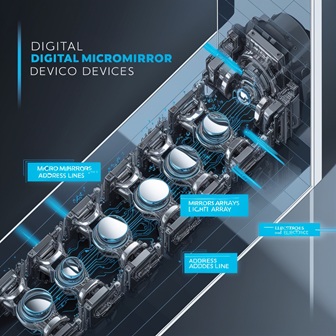Introduction
Digital Micromirror Devices (DMDs): Imagine a device with thousands of tiny mirrors, each smaller than a pinhead, working together in perfect harmony to project dazzling images, guide precision surgeries, or create intricate 3D-printed models. That’s the magic of Digital Micromirror Devices (DMDs). As a cornerstone of modern light-processing technology, DMDs are transforming industries with their speed, precision, and versatility. In this article, we’ll dive deep into the nine most compelling features of DMDs and explore how they’re reshaping the future of technology.

What Are Digital Micromirror Devices?
Definition and Functionality
Digital Micromirror Devices are micro-electromechanical systems (MEMS) that consist of an array of microscopic mirrors. Each mirror is mounted on a hinge and can tilt to reflect light in specific directions. By individually controlling each mirror, DMDs modulate light with incredible precision, making them an integral part of systems like digital light processing (DLP) projectors, medical imaging tools, and 3D printers.
Core Technology Behind DMDs
Each mirror in a DMD operates independently, tilting on an axis at speeds of up to thousands of times per second. These rapid adjustments allow DMDs to create detailed and dynamic light patterns that form images or guide other processes, such as laser cutting or optical communication.
Brief History of DMD Development
DMD technology was pioneered in the late 1980s by Texas Instruments, a company that remains a leader in this field. Initially designed for DLP projectors, DMDs have since evolved into multi-purpose tools with applications across medical, industrial, and entertainment sectors. Digital Micromirror Devices (DMDs)
Key Applications of DMDs
Display Technology
DLP Projectors
DMDs are the heart of DLP projectors, providing unmatched image quality. Each mirror corresponds to a single pixel, and their rapid movements allow for vibrant, high-definition visuals. These projectors are widely used in education, business presentations, and home theaters. Digital Micromirror Devices (DMDs)
Home Entertainment and Theaters
In cinematic environments, DMDs deliver stunning resolution, deep contrasts, and brilliant colors. They are the go-to choice for digital cinema projection, ensuring moviegoers experience films in their full glory.
Medical Imaging
Endoscopy and Surgical Imaging
DMDs enhance the clarity and precision of endoscopic tools, aiding surgeons in performing minimally invasive procedures with greater accuracy.
Enhanced Precision in Diagnostics
They also play a role in advanced imaging systems, such as those used in oncology and ophthalmology, where detail and accuracy are critical for effective diagnosis and treatment. Digital Micromirror Devices (DMDs)
3D Printing
High-Resolution Printing
In additive manufacturing, DMDs facilitate the creation of intricate designs by directing laser beams or UV light to cure resin layers with pinpoint precision.
Role in Prototyping and Manufacturing
Their ability to project complex patterns rapidly makes DMDs essential in producing prototypes for industries like aerospace, healthcare, and consumer goods. Digital Micromirror Devices (DMDs)
Optical Communication Systems
DMDs contribute to faster and more reliable data transmission in optical networks. By dynamically controlling light signals, they improve the efficiency and performance of communication systems.

9 Powerful Features of DMDs
Feature 1: Exceptional Light Control
Precision in Light Modulation
DMDs can manipulate light with extreme accuracy, down to fractions of a degree. This makes them indispensable for applications requiring detailed light control, such as surgical lasers and advanced microscopy. Digital Micromirror Devices (DMDs)
Benefits for Display Technologies
In displays, precise light modulation translates to sharper images, higher contrast ratios, and better color representation.
Feature 2: High-Speed Performance
Quick Response Times
DMDs can adjust the angle of their mirrors thousands of times per second, enabling real-time light modulation. This rapid response is essential for dynamic applications like video projection and optical switching. Digital Micromirror Devices (DMDs)
Applications in High-Demand Scenarios
High-speed performance makes DMDs ideal for applications in which delays are unacceptable, such as gaming, live event broadcasting, and military operations.
Feature 3: Scalability
Customizable Array Sizes
DMDs are available in various sizes, ranging from compact arrays for portable devices to large arrays for industrial machinery. This scalability makes them suitable for a wide range of applications.
Use in Diverse Industries
From high-resolution advertising billboards to intricate scientific instruments, DMDs cater to industries of all shapes and sizes.
Feature 4: Durability and Longevity
Robust Design
Engineered with high-quality materials, DMDs are built to withstand harsh environments, including extreme temperatures and vibrations. Digital Micromirror Devices (DMDs)
Extended Lifespan in Various Applications
Their durable design ensures consistent performance over time, reducing the need for frequent replacements and lowering maintenance costs.

Feature 5: Energy Efficiency
Reduced Power Consumption
Compared to other light control technologies, DMDs require less energy to operate, making them an eco-friendly option for many applications.
Environmental Benefits
Their energy efficiency helps reduce the overall carbon footprint, aligning with global sustainability goals. Digital Micromirror Devices (DMDs)
Feature 6: High Resolution
Contribution to Clarity in Displays
By allowing precise control of millions of mirrors, DMDs enable ultra-high-definition visuals, making them ideal for 4K and even 8K displays.
Role in Scientific and Industrial Applications
In scientific research, DMDs aid in high-resolution imaging for applications like cellular analysis, astronomy, and material studies.
Feature 7: Compact Design
Space-Saving Benefits
DMDs’ compact size allows them to be integrated into portable and lightweight devices, such as handheld projectors or drones.
Ease of Integration into Devices
Their small footprint simplifies the design of complex systems, making them more versatile and accessible.

Feature 8: Versatility
Suitability for Diverse Wavelengths
DMDs can handle a wide spectrum of light, including ultraviolet (UV) and infrared (IR), broadening their application range beyond visible light.
Applications Beyond Visible Light
Their ability to work with non-visible wavelengths makes them valuable in fields like spectroscopy, night vision, and thermal imaging.
Feature 9: Real-Time Adaptability
Instantaneous Adjustments
DMDs can dynamically adjust their settings in real time, responding to changing conditions without delay. This feature is particularly useful in interactive applications like augmented reality (AR) and virtual reality (VR).
Benefits in Interactive and Dynamic Systems
Their adaptability enhances user experience in gaming, training simulators, and other systems requiring immediate feedback.

Future Trends in DMD Technology
Innovations on the Horizon
Researchers are exploring ways to make DMDs even smaller, faster, and more efficient. Future innovations may include integration with AI for automated light adjustments and the development of new materials for enhanced performance.
Expanding Use Cases in Emerging Industries
As industries like autonomous vehicles and quantum computing emerge, DMDs are likely to find new roles in guiding lasers, optimizing sensors, and managing complex optical systems.
Conclusion
Digital Micromirror Devices have truly revolutionized the way we manipulate light. Their precision, speed, and versatility make them indispensable across industries. Whether it’s enhancing your movie-watching experience, improving surgical outcomes, or enabling futuristic 3D printing, DMDs are at the forefront of innovation. As technology evolves, these tiny mirrors will continue to unlock new possibilities, shaping the future of multiple domains.
FAQs
1. What are Digital Micromirror Devices (DMDs)?
DMDs are arrays of microscopic mirrors used to control light with exceptional precision, widely employed in projectors, medical imaging, and optical systems.
2. How do DMDs work?
Each mirror in a DMD tilts rapidly to direct light in specific directions, creating dynamic patterns that can form images or guide lasers.
3. What industries benefit from DMD technology?
DMDs are used in entertainment, healthcare, manufacturing, telecommunications, and scientific research.
4. Are DMDs environmentally friendly?
Yes, DMDs consume less energy compared to many traditional technologies, contributing to reduced environmental impact.
5. What’s next for DMDs?
Future advancements include higher resolution, AI integration, and expanded applications in emerging technologies like quantum computing and autonomous systems.

